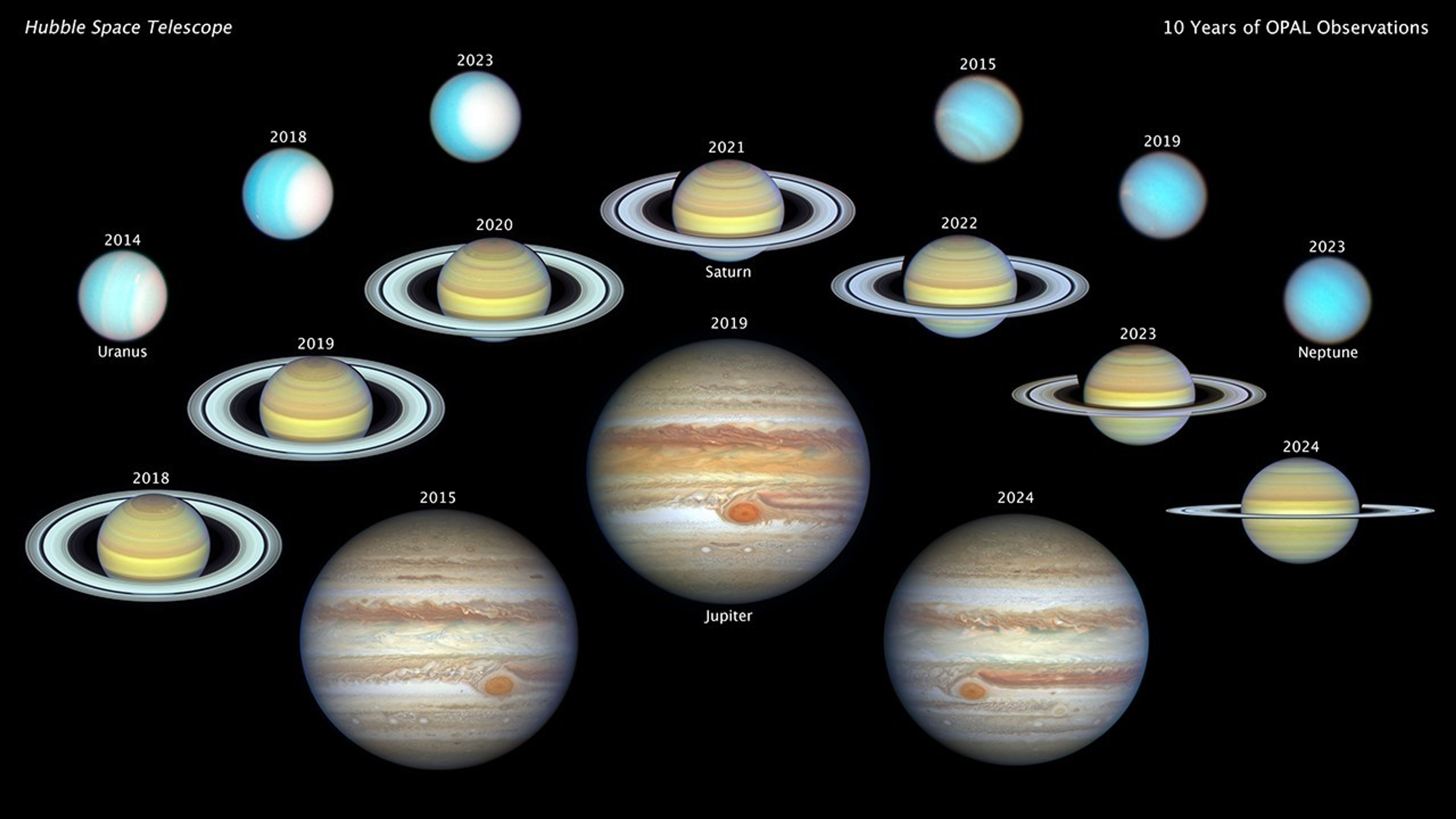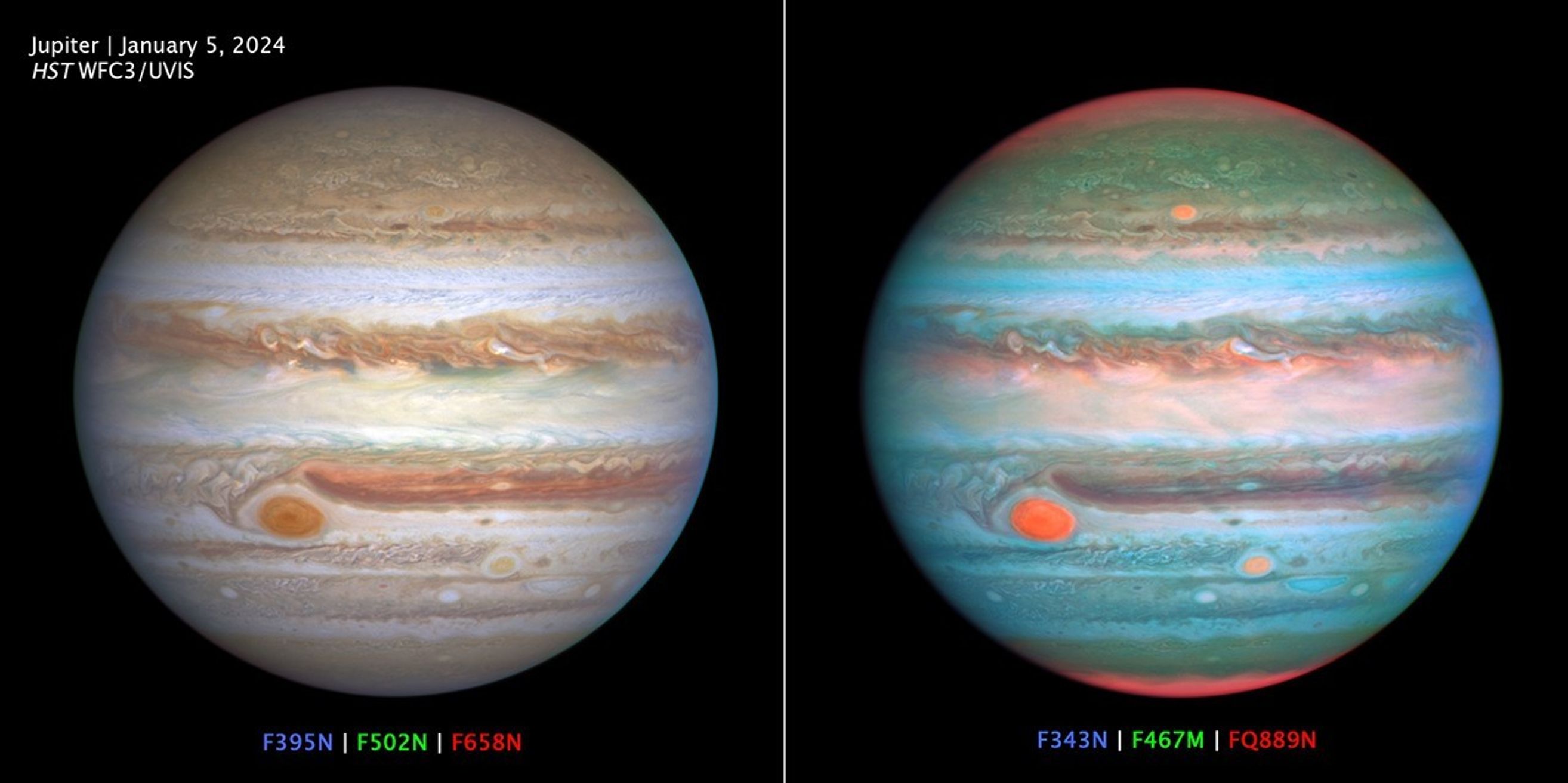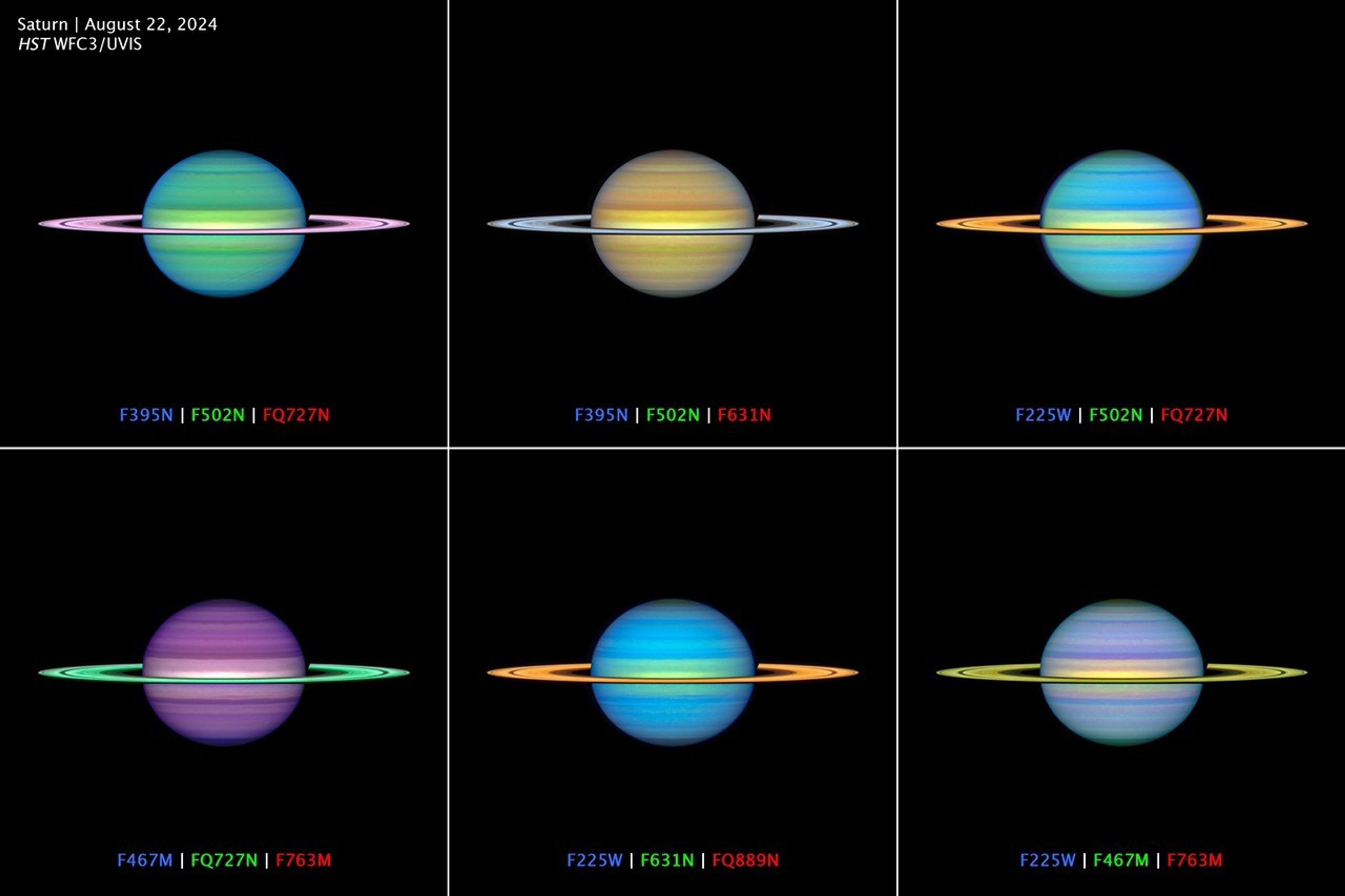NASA’s Hubble Celebrates Decade of Tracking Outer Planets
Encountering Neptune in 1989, NASA’s Voyager mission completed humankind’s first close-up exploration of the four giant outer planets of our solar system. Collectively, since their launch in 1977, the twin Voyager 1 and Voyager 2 spacecraft discovered that Jupiter, Saturn, Uranus, and Neptune were far more complex than scientists had imagined. There was a lot […]

NASA’s Hubble Celebrates Decade of Tracking Outer Planets

NASA, ESA, Amy Simon (NASA-GSFC), Michael H. Wong (UC Berkeley); Image Processing: Joseph DePasquale (STScI)
Encountering Neptune in 1989, NASA’s Voyager mission completed humankind’s first close-up exploration of the four giant outer planets of our solar system. Collectively, since their launch in 1977, the twin Voyager 1 and Voyager 2 spacecraft discovered that Jupiter, Saturn, Uranus, and Neptune were far more complex than scientists had imagined. There was a lot more to be learned.
A NASA Hubble Space Telescope observation program called OPAL (Outer Planet Atmospheres Legacy) obtains long-term baseline observations of Jupiter, Saturn, Uranus, and Neptune in order to understand their atmospheric dynamics and evolution.
“The Voyagers don’t tell you the full story,” said Amy Simon of NASA’s Goddard Space Flight Center in Greenbelt, Maryland, who conducted giant planet observations with OPAL.
Hubble’s image sharpness is comparable to the Voyager views as they approached the outer planets, and Hubble spans wavelengths from ultraviolet to near-infrared light. Hubble is the only telescope that can provide high spatial resolution and image stability for global studies of cloud coloration, activity, and atmospheric motion on a consistent time basis to help constrain the underlying mechanics of weather and climate systems.

All four of the outer planets have deep atmospheres and no solid surfaces. Their churning atmospheres have their own unique weather systems, some with colorful bands of multicolored clouds, and with mysterious, large storms that pop up or linger for many years. Each outer planet also has seasons lasting many years. (The James Webb Space Telescope’s infrared capabilities will be used to probe deep into atmospheres of the outer planets to complement the OPAL observations.)
Following the complex behavior is akin to understanding Earth’s dynamic weather as followed over many years, as well as the Sun’s influence on the solar system’s weather. The four distant worlds also serve as proxies for understanding the weather and climate on similar planets orbiting other stars.
Planetary scientists realized that any one year of data from Hubble, while interesting in its own right, doesn’t tell the full story of the outer planets. Hubble’s OPAL program has routinely observed the planets once a year when they are closest to the Earth.
“Because OPAL now spans 10 years and counting, our database of planetary observations is ever growing. That longevity allows for serendipitous discoveries, but also for tracking long-term atmospheric changes as the planets orbit the Sun. The scientific value of these data is underscored by the more than 60 publications to date that include OPAL data,” said Simon.
This payoff continues to be a huge archive of data that has led to a string of remarkable discoveries to share with planetary astronomers around the world. “OPAL also interfaces with other ground- and space-based planetary programs. Many papers from other observatories and space missions pull in Hubble data from OPAL for context,” said Simon.
The team’s decade of discovery under Hubble’s OPAL program is being presented at the December meeting of the American Geophysical Union in Washington, D.C.
SOME HIGHLIGHTS:
JUPITER

Jupiter’s bands of clouds present an ever-changing kaleidoscope of shapes and colors. There is always stormy weather on Jupiter: cyclones, anticyclones, wind shear, and the largest storm in the solar system, the Great Red Spot (GRS). Jupiter is covered with largely ammonia ice-crystal clouds on top of an atmosphere that’s tens of thousands of miles deep.

Hubble’s sharp images track clouds and measure the winds, storms, and vortices, in addition to monitoring the size, shape, and behavior of the GRS. Hubble follows as the GRS continues shrinking in size and its winds are speeding up. OPAL data recently measured how often mysterious dark ovals — visible only at ultraviolet wavelengths — appeared in the “polar hoods” of stratospheric haze. Unlike Earth, Jupiter is only inclined three degrees on its axis (Earth is 23.5 degrees). Seasonal changes might not be expected, except that Jupiter’s distance from the Sun varies by about 5% over its 12-year-long orbit, and so OPAL closely monitors the atmosphere for seasonal effects. Another Hubble advantage is that ground-based observatories can’t continuously view Jupiter for two Jupiter rotations, because that adds up to 20 hours. During that time, an observatory on the ground would have gone into daytime and Jupiter would no longer be visible until the next evening.
SATURN

Saturn takes more than 29 years to orbit the Sun, and so OPAL has followed it for approximately one quarter of a Saturnian year (picking up in 2018, after the end of the Cassini mission). Because Saturn is tilted 26.7 degrees, it goes through more profound seasonal changes than Jupiter. Saturnian seasons last approximately seven years. This also means Hubble can view the spectacular ring system from an oblique angle of almost 30 degrees to seeing the rings tilted edge-on. Edge-on, the rings nearly vanish because they are relatively paper-thin. This will happen again in 2025.
OPAL has followed changes in colors of Saturn’s atmosphere. The varying color was first detected by the Cassini orbiter, but Hubble provides a longer baseline. Hubble revealed slight changes from year-to-year in color, possibly caused by cloud height and winds. The observed changes are subtle because OPAL has covered only a fraction of a Saturnian year. Major changes happen when Saturn progresses into the next season.
Saturn’s mysteriously dark ring spokes, which slice across the ring plane, are transient features that rotate along with the rings. Their ghostly appearance only persists for two or three rotations around Saturn. During active periods, freshly formed spokes continuously add to the pattern. They were first seen in 1981 by Voyager 2. Cassini also saw the spokes during its 13-year-long mission, which ended in 2017. Hubble shows that the frequency of spoke apparitions is seasonally driven, first appearing in OPAL data in 2021. Long-term monitoring shows that both the number and contrast of the spokes vary with Saturn’s seasons.
URANUS
Uranus is tilted on its side so that its spin axis almost lies in the plane of the planet’s orbit. This results in the planet going through radical seasonal changes along it 84-year-long trek around the Sun. The consequence of the planet’s tilt means part of one hemisphere is completely without sunlight, for stretches of time lasting up to 42 years. OPAL has followed the northern pole now tipping toward the Sun.
With OPAL, Hubble first imaged Uranus after the spring equinox, when the Sun was last shining directly over the planet’s equator. Hubble resolved multiple storms with methane ice-crystal clouds appearing at mid-northern latitudes as summer approaches the north pole. Uranus’ north pole now has a thickened photochemical haze with several little storms near the edge of the boundary. Hubble has been tracking the size of the north polar cap and it continues to get brighter year after year. As northern summer solstice approaches in 2028, the cap may grow brighter still, and will be aimed directly toward Earth, allowing good views of the rings and north pole. The ring system will then appear face-on. Understanding how Uranus changes over time will help in mission planning for NASA’s proposed Uranus Orbiter and Probe.
NEPTUNE
When Voyager 2 flew by Neptune in 1989, astronomers were mystified by a great dark spot the size of the Atlantic Ocean looming in the atmosphere. Was it long-lived like Jupiter’s Great Red Spot? The question remained unanswered until Hubble was able to show in 1994 that such dark storms were transitory, cropping up and then disappearing over a duration of two to six years each. During the OPAL program, Hubble saw the end of one dark spot and the full life cycle of a second one — both of them migrating toward the equator before dissipating. The OPAL program ensures that astronomers won’t miss another one.
Hubble observations uncovered a link between Neptune’s shifting cloud abundance and the 11-year solar cycle. The connection between Neptune and solar activity is surprising to planetary scientists because Neptune is our solar system’s farthest major planet. It receives only about 1/1000th as much sunlight as Earth receives. Yet Neptune’s global cloudy weather seems to be influenced by solar activity. Do the planet’s seasons also play a role?
The Hubble Space Telescope has been operating for over three decades and continues to make ground-breaking discoveries that shape our fundamental understanding of the universe. Hubble is a project of international cooperation between NASA and ESA (European Space Agency). NASA’s Goddard Space Flight Center in Greenbelt, Maryland, manages the telescope and mission operations. Lockheed Martin Space, based in Denver, also supports mission operations at Goddard. The Space Telescope Science Institute in Baltimore, which is operated by the Association of Universities for Research in Astronomy, conducts Hubble science operations for NASA.
Explore More
Media Contact:
Claire Andreoli (claire.andreoli@nasa.gov)
NASA’s Goddard Space Flight Center, Greenbelt, MD
Ray Villard
Space Telescope Science Institute, Baltimore, MD
Science Contact:
Amy Simon
NASA’s Goddard Space Flight Center, Greenbelt, MD
Michael H. Wong
University of California, Berkeley, CA
What's Your Reaction?













































